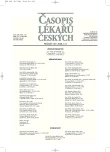Spontaneous Pneumothorax
Authors:
J. Vodička; V. Špidlen
Authors‘ workplace:
Chirurgická klinika LF UK a FN, Plzeň
Published in:
Čas. Lék. čes. 2006; 145: 611-615
Category:
Review Article
Overview
Spontaneous pneumothorax comprises app. 0.1–2 % of surgical diseases. There are four subtypes; primary, secondary, catamenial and neonatal. Aetiology of primary pneumothorax is not exactly known since there is no direct relation to any basic lung disease. Nevertheless, in most patients (80–85 %), it develops due to the rupture of an emphysematous bulla or a subpleural air bubble, i.e. blebs. On the other hand, secondary pneumothorax is a result or a complication of a verified localized or general lung disorder. Catamenial pneumothorax is a recurrent lung collapse in women at the time of menstruation. Neonatal pneumothorax is found typically in immature or premature newborns, often in association with congenital lung disorders. From the pathological point of view, it is an acute disorder of distribution of blood gasses in lungs with subsequent hypoxemia, which can be identified as an acute thoracic event. The clinical picture of pulmonary collapse is characterised by a triad of symptoms – dyspnoea, pleuritic pain and dry and non-productive cough. The diagnosis is usually determined on the base of history and after a careful clinical examination. It is then verified on lung X-ray. The objective of therapy of spontaneous pneumothorax is to restore permanent lung expansion to the original extent. Conservative treatment is chosen in the first episodes of pneumothorax with small extent and without further complications or symptoms. In the rest of cases, the surgical treatment is necessary, which includes puncture of the pleural cavity, drainage and surgical revision using videothoracoscopy or thoracotomy. In general, in case of the first episode of pulmonary collapse it is recommended to perform less radical procedure, i.e. drainage of the pleural cavity. Recurrences of the disease are indicated for surgical treatment; primarily miniinvasive procedures, in which the site of air leaking from lung parenchyma is closed and also an artificial pleural symphysis is created to prevent recurrence of the collapse. This type of procedure provides best results; recurrence is not exceeding 3%.
Key words:
spontaneous pneumothorax, drainage, videothoracoscopy.
Labels
Addictology Allergology and clinical immunology Angiology Audiology Clinical biochemistry Dermatology & STDs Paediatric gastroenterology Paediatric surgery Paediatric cardiology Paediatric neurology Paediatric ENT Paediatric psychiatry Paediatric rheumatology Diabetology Pharmacy Vascular surgery Pain management Dental HygienistArticle was published in
Journal of Czech Physicians

Most read in this issue
- Spontaneous Pneumothorax
- Meconium Ileus as a First Symptom of Cystic Fibrosis in a Newborn
- Extent of Tuberculin Skin Testing Spot in Bacteriologically Verified Tuberculosis
- Mitochondrial Neurogastrointestinal Encephalomyopathy (MNGIE)
